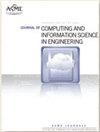科学计算中的物理引导、物理信息和物理编码神经网络与运算器》(Physics-Guided, Physics-Informed, and Physics-Encoded Neural Networks and Operators in Scientific Computing):流体与固体力学
IF 2.6
3区 工程技术
Q2 COMPUTER SCIENCE, INTERDISCIPLINARY APPLICATIONS
Journal of Computing and Information Science in Engineering
Pub Date : 2024-01-08
DOI:10.1115/1.4064449
引用次数: 2
摘要
近来,计算能力的进步使得利用机器学习和深度学习推动流体力学、固体力学、材料科学等一系列学科的科学计算成为可能。在这一混合过程中,神经网络的融入尤为关键。由于其固有的架构,传统的神经网络无法在数据稀少的情况下成功地进行训练和扩展,而许多科学和工程领域都存在这种情况。不过,神经网络为在训练过程中尊重物理驱动或知识约束提供了坚实的基础。一般来说,有三种不同的神经网络框架来执行底层物理:(i) 物理引导神经网络 (PgNN),(ii) 物理信息神经网络 (PiNN),以及 (iii) 物理编码神经网络 (PeNN)。这些方法在加速复杂多尺度多物理现象的数值建模方面具有明显优势。此外,神经算子(NOs)的最新发展为这些新的模拟范式增添了新的维度,尤其是在需要对复杂的多物理场系统进行实时预测时。所有这些模型都有其独特的缺点和局限性,需要进一步的基础研究。本研究旨在对科学计算研究中使用的四种神经网络框架(即 PgNNs、PiNNs、PeNNs 和 NOs)进行综述。本研究回顾了最先进的架构及其应用,讨论了其局限性,并从改进算法、考虑因果关系、扩展应用以及科学与深度学习求解器耦合等方面提出了未来的研究机会。本文章由计算机程序翻译,如有差异,请以英文原文为准。
Physics-Guided, Physics-Informed, and Physics-Encoded Neural Networks and Operators in Scientific Computing: Fluid and Solid Mechanics
Advancements in computing power have recently made it possible to utilize machine learning and deep learning to push scientific computing forward in a range of disciplines, such as fluid mechanics, solid mechanics, materials science, etc. The incorporation of neural networks is particularly crucial in this hybridization process. Due to their intrinsic architecture, conventional neural networks cannot be successfully trained and scoped when data is sparse, which is the case in many scientific and engineering domains. Nonetheless, neural networks provide a solid foundation to respect physics-driven or knowledge-based constraints during training. Generally speaking, there are three distinct neural network frameworks to enforce the underlying physics: (i) physics-guided neural networks (PgNNs), (ii) physics-informed neural networks (PiNNs), and (iii) physics-encoded neural networks (PeNNs). These methods provide distinct advantages for accelerating the numerical modeling of complex multiscale multi-physics phenomena. In addition, the recent developments in neural operators (NOs) add another dimension to these new simulation paradigms, especially when the real-time prediction of complex multi-physics systems is required. All these models also come with their own unique drawbacks and limitations that call for further fundamental research. This study aims to present a review of the four neural network frameworks (i.e., PgNNs, PiNNs, PeNNs, and NOs) used in scientific computing research. The state-of-the-art architectures and their applications are reviewed, limitations are discussed, and future research opportunities are presented in terms of improving algorithms, considering causalities, expanding applications, and coupling scientific and deep learning solvers.
求助全文
通过发布文献求助,成功后即可免费获取论文全文。
去求助
来源期刊
CiteScore
6.30
自引率
12.90%
发文量
100
审稿时长
6 months
期刊介绍:
The ASME Journal of Computing and Information Science in Engineering (JCISE) publishes articles related to Algorithms, Computational Methods, Computing Infrastructure, Computer-Interpretable Representations, Human-Computer Interfaces, Information Science, and/or System Architectures that aim to improve some aspect of product and system lifecycle (e.g., design, manufacturing, operation, maintenance, disposal, recycling etc.). Applications considered in JCISE manuscripts should be relevant to the mechanical engineering discipline. Papers can be focused on fundamental research leading to new methods, or adaptation of existing methods for new applications.
Scope: Advanced Computing Infrastructure; Artificial Intelligence; Big Data and Analytics; Collaborative Design; Computer Aided Design; Computer Aided Engineering; Computer Aided Manufacturing; Computational Foundations for Additive Manufacturing; Computational Foundations for Engineering Optimization; Computational Geometry; Computational Metrology; Computational Synthesis; Conceptual Design; Cybermanufacturing; Cyber Physical Security for Factories; Cyber Physical System Design and Operation; Data-Driven Engineering Applications; Engineering Informatics; Geometric Reasoning; GPU Computing for Design and Manufacturing; Human Computer Interfaces/Interactions; Industrial Internet of Things; Knowledge Engineering; Information Management; Inverse Methods for Engineering Applications; Machine Learning for Engineering Applications; Manufacturing Planning; Manufacturing Automation; Model-based Systems Engineering; Multiphysics Modeling and Simulation; Multiscale Modeling and Simulation; Multidisciplinary Optimization; Physics-Based Simulations; Process Modeling for Engineering Applications; Qualification, Verification and Validation of Computational Models; Symbolic Computing for Engineering Applications; Tolerance Modeling; Topology and Shape Optimization; Virtual and Augmented Reality Environments; Virtual Prototyping

 求助内容:
求助内容: 应助结果提醒方式:
应助结果提醒方式:


